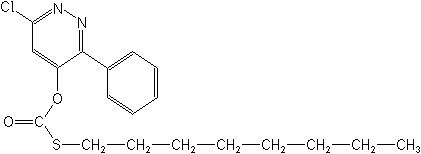-
Physical Properties
Molecular weight:378.9; Physical form:Colourless crystals; ( tech., brown, oily liquid). Density:1.16 (20 °C) ( tech.); Melting point:27 °C; ( tech., 20-25 °C); Flash point:131 °C; Vapour pressure:4.8 ×10-4 mPa (20 °C) ( tech.); Henry constant:1.21 × 10-4 Pa m3 mol-1 (20 °C) ( calc.); Partition coefficient(n-octanol and water):logP = 4.01; Solubility:In water c. 1.5 mg/l ( pH 7, 20 °C). Readily soluble in most organic solvents.; Stability:Hydrolysis DT50 89 h ( pH 5), 58.5 h ( pH 7), 6.2 h ( pH 9) (all 25 °C).
-
Toxicology
Oral:Acute oral LD50 for male and female rats >2000, male mice c. 10 000, female mice >10 000 mg/ kg. Percutaneous:Acute percutaneous LD50 for rabbits >2000 mg/kg. Moderately irritating to skin; non-irritating to eyes (rabbits). Evidence of sensitisation in guinea pigs, but no symptoms observed in man (applicators Inhalation: LC50 (4 h) for rats >4.37 mg/l air. Phytotoxicity:Should not be applied in mixture with, or within 14 days of, any oth
-
Environmental Profile
Ecotoxicology:
Algae: IC50 for Scenedesmus subspicatus 82.1 mg/l.Bees:Non-toxic to honeybees. LD50 (oral and contact) >100 ×g/bee.Birds:Acute oral LD50 for bobwhite quail 1269-1502 mg/kg. Dietary LC50 (8 d) for Japanese quail, bobwhite quail and mallard ducks >5000 mg/ kg b.w.Daphnia: LC50 0.83 mg/l; in simulated field, 3.3-7.1 mg/l.Fish: LC50 (96 h) for catfish 48, rainbow trout >1.2 to 81, bluegill sunfish >2.12 to >100, carp >100 mg/l.Worms: LC50 for earthworms 799 mg/ kg soil.Other beneficial spp.:Harmless to beneficial arthropods such as Poecilus and Aleochara ('Lentagran' 450EC). No effect on soil respiration, ammonification and nitrification.
Environmental fate:
Animals:In animals, following oral administration, pyridate is rapidly and completely hydrolysed to its principal metabolite 3-phenyl-4-hydroxy-6-chloropyridazine, which is detoxified by formation of O- and, depending on species, N- glucuronidesSoil:Rapidly degraded in soil, DT50 <2.8 d. The principal metabolite is 3-phenyl-4-hydroxy-6-chloropyridazine, which typically has DT50 7-21 d (field), 15-43 d (lab.); DT90 47-143 d (lab.). In biPlant:In plants, pyridate is hydrolysed into its principal metabolite 3-phenyl-4-hydroxy-6-chloropyridazine, with a half-life ranging from a few minutes to days. This metabolite itself forms conjugates as O- and N-glycosides, which do not poss WATER SOLUBILITY: 1.5 mg/l at 20°C (pH 7)
-
Transport Information
Signal Word:CAUTION; Hazard Class:III(Slightly hazardous)

 0
0 Subscribe
Subscribe
